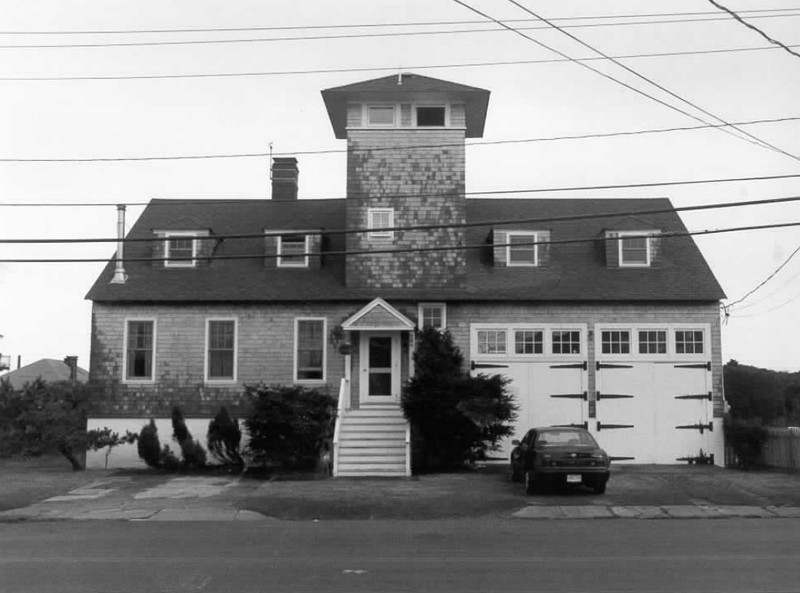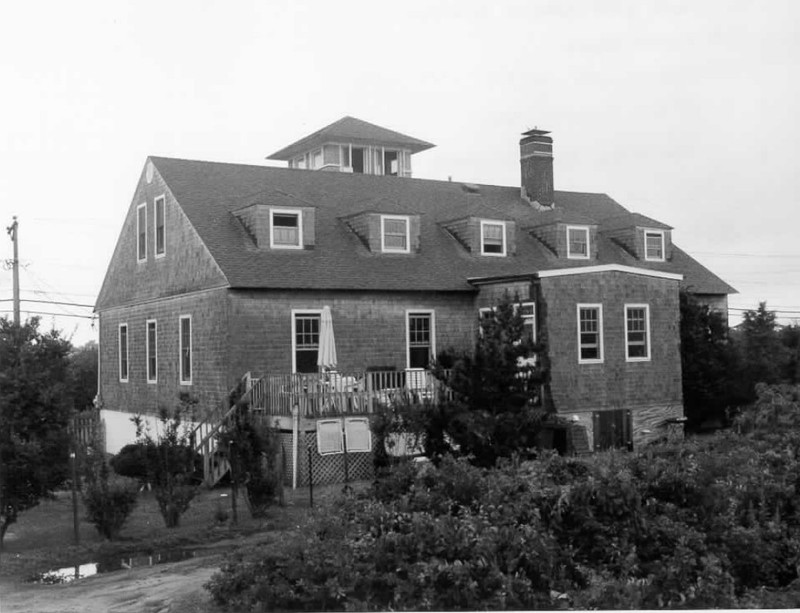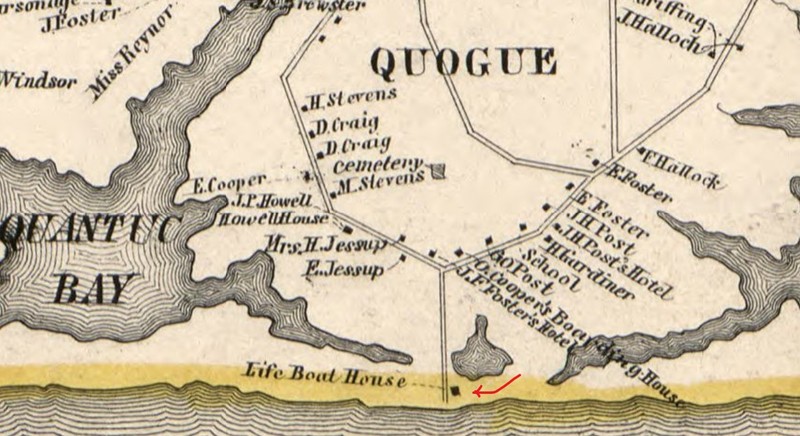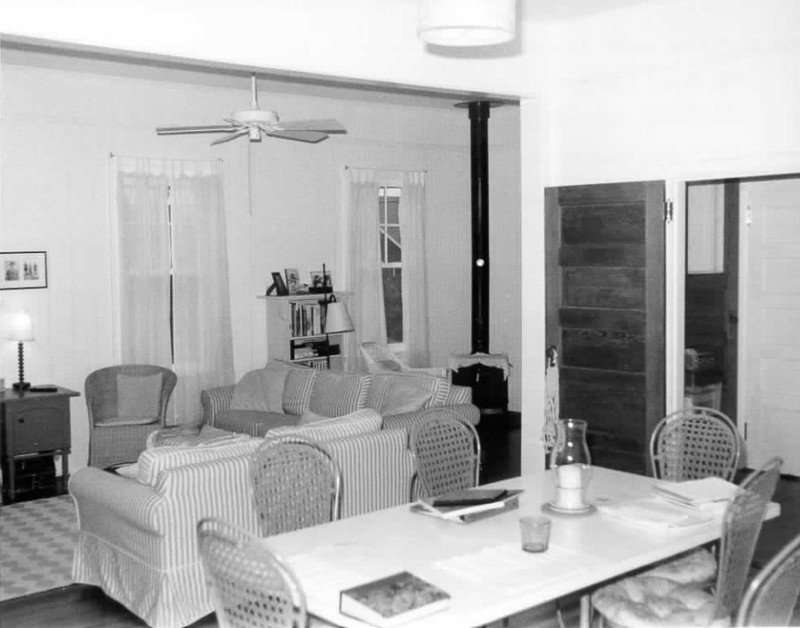Quogue Life-Saving Station
Introduction
Text-to-speech Audio
Quogue's Life-Saving Station was built on the barrier island in 1912 in the Shingle Style from one of the standard plans for U.S. Life-Saving Service buildings. It was next door to the first life-saving station that was built on this site in 1872. Previously, a boat house built on the island in 1849 was used by volunteers to aid in water rescues from shipwrecks. The Life-Saving Service and the Revenue Cutter Service merged to become the U.S. Coast Guard in 1915 and the station was sold to the U.S. Navy. The building has been a private residence since purchased from the Coast Guard in the late 1940s and has been owned by two different families since then. The Quogue Life-Saving Station was listed in the New York and National Registers of Historic Places in 1999. The Quogue Station is one of the most intact of the dozen stations built on Long Island before 1915.
Images
Front of Quogue Life-Saving Station in 1998 photo for NRHP, looking S (Wick York)

Back & west side of Quogue Life-Saving Station in 1998 photo, looking NE (Wick York)

Original Life-Saving Station ("Life Boat House") on 1858 map of Suffolk County (Robert P. Smith)

East living room inside Quogue Life-Saving Station in 1998 photo (Wick York)

Backstory and Context
Text-to-speech Audio
The U.S. Life-Saving Service was established in 1848 as part of the U.S. Treasury Department; its purpose was to rescue people from coastal maritime disasters. The original life-saving station in this spot was in an isolated location when it was constructed in 1872. The old station was standing adjacent to the new, larger station built in 1912. The 1872 station building was used for storage from 1912 to 1916 or so, when it was moved off of the property, about 300 feet to the east. The 1872 station had been converted to a private residence and was still occupied as of 1999.
The 1912 building is one and a half stories with a gable roof pierced by a four-story, hipped roof tower flanked by four dormer windows on the north side and five dormer windows on the south side. The wood shingle clad building is on a poured concrete foundation raised about four feet off the ground level and is sheltered from the Atlantic Ocean by a dune to the south. The front door leads to a small hall under the tower stairs. The crew quarters were on the second floor. Several changes were made during the life of the Coast Guard use of the building, including extending the kitchen southward and lowering the floor above and below the surf boat and equipment bays (now a garage with a living room above). The wood shingled original roof has been replaced with asphalt shingles and the wood shingled exterior has been covered with cement-asbestos shingles.
Dune Road, the main east-west road across the barrier island, was opened in 1910 to 1911. Summer residences started to be built nearby around the turn of the twentieth century. Some of the married Coast Guard employees also built small houses for their families nearby. Two other U.S. Life-Saving stations of the same "Lorain" design as Quogue survive on Long Island, at Tiana and Blue Point; both of these have had significantly more alterations and are in poorer condition than Quogue's. The use of motorized boats by the coastal life-saving service began around 1905 on Long Island. As motorized ships became more common, crews could cover wider areas from their home base, resulting in the need for fewer life-saving stations. Not having to row through churning surfs to reach coastal accident sites also gave the crews an edge. The motto of the lifesavers was "You have to go out, but you don't have to come back."
The Quogue Life-Saving Station was deactivated in 1937 but reactivated in 1939 in the lead-up to World War II. During a hurricane in 1938, locals broke into the vacant building to escape coastal flooding and survived within the tower. The station was closed for good in 1948 after a regional station was built at Ponquogue Point in Shinnecock. The Coast Guard divided the Quogue property into three lots and sold each to private owners, with the station in the middle lot. The side lots have each had homes built on them since.
The Calloway family purchased the 1912 life saving station from the U.S. Coast Guard and used the property as a home for many years. Later, the property was a summer rental called "Under Dune." One of those summer rentals in 1993 was to John and Wendy Cooney. The couple enjoyed staying there so much that they bought the property from the Calloways. The Cooneys spent several years renovating the building, keeping historic preservation in mind; they maintain a website for the life-saving station (linked below) they call home.
Sources
Warren, James. York, Wick. NRHP Nomination of Quogue Life-Saving Station, Quogue, N.Y.. National Register. Washington, DC. National Park Service, 1999.
Cooney, John. Welcome to the Home of the Quogue Life Saving Station, U.S. Life Saving Service Station Quogue. April 19th 2015. Accessed June 10th 2021. http://quoguelifesavingstation.com/welcome-to-the-home-of-the-quogue-life-saving-station/.
New York State Cultural Resource Information System (NYS CRIS): https://cris.parks.ny.gov/
NYS CRIS: https://cris.parks.ny.gov/
Library of Congress: https://www.loc.gov/item/2013593235/
NYS CRIS: https://cris.parks.ny.gov/
